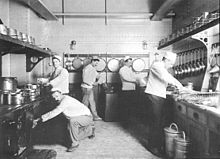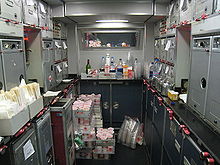Galley (kitchen)

The galley is the compartment of a ship, train or aircraft where food is cooked and prepared. It can also refer to a land based kitchen on a naval base or a particular formed household kitchen.
Ship's kitchen

A galley is the kitchen aboard a vessel, usually laid out in an efficient typical style with longitudinal units and overhead cabinets. This makes the best use of the usually limited space aboard ships. It also caters for the rolling and heaving nature of ships, making them more resistant to the effects of the movement of the ship. For this reason galley stoves are often gimballed, so that the liquid in pans does not spill out. They are also commonly equipped with bars, preventing the cook from falling against the hot stove.
A small kitchen on deck was called a caboose or camboose, originating from the Dutch: kombuis which is still in use today. In English it is a defunct term used only for a cooking area that is abovedecks.[1]
Household kitchen
The term Galley kitchen is also used to refer to the design of household kitchen where the units are fitted into a continuous array with no kitchen table, allowing the maximum use of a restricted space, and allowing work with the minimum of required movement between units. Such kitchens increase storage space by working vertically, with hanging pots, dish racks and ceiling-hung cabinets common. Strictly, the term refers to a kitchen with the units in two facing lines, but is often used to refer to U-shaped kitchens as well.
The first mass-produced galley kitchen design was known as the Frankfurt kitchen, designed by Margarete Schütte-Lihotzky, working under the direction of Ernst May in 1926 for a Frankfurt housing estate. 10,000 units were installed in Frankfurt, and it was the most successful and influential kitchen of the period.
Aviation kitchen

The Douglas Aircraft DC-3 was the first airplane with a planned galley for food service.[2] Galleys on commercial airlines typically include not only facilities to serve and store food and beverages, but also contain flight attendant jumpseats, emergency equipment storage, as well as anything else flight attendants may need during the flight.
Aircraft in operation today mainly use the familiar trolley system. This system was introduced in the late 1960s at the same time as a new generation of large "widebody" aircraft were entering into service with the airlines. The significantly larger number of passengers on these aircraft meant that meals could no longer be efficiently delivered by hand, as they had been up until that point.
There are two main sizes of trolley in use with the airlines around the world, called the "ATLAS" and "KSSU" sizes. ATLAS is by far the most common size with approximately 80% of airlines using it. Remaining users of KSSU include KLM and Cathay Pacific.
Airbus has developed a new galley concept called SPICE, which they publicise as a potential new worldwide standard with significant advantages over the current 40 year old trolley technology.[3] The Airbus 380 contains 73% of galley technologie developed and delivered by Sell GmbH.
Werner Sell
The first airplane kitchen was invented (patent) by Werner Sell (Georg Robert Werner Sell) of Germany in 1930; the first fitted kitchens were delivered 1954, by 1955 Lufthansa had all their commercial planes fitted with a Sell galley. Werner Sell is also considered the inventor of the fitted kitchen. In 1955 Sell also began fitting train coaches with kitchens, from 1960 on with the newly developed convection oven. The Frankfurt kitchen needed an exact space, whereas the Sell kitchen could be fitted anywhere. Sell is further considered as the inventor of the prefabricated house (Sell-Fertighaus GmbH). After World War II until 1948 his company built over 5000 prefabricated houses in Germany for members of the occupying force of the United States of America.
References
- ^ Caboose. Retrieved 2009-12-27.
- ^ Delta Air Lines Museum Douglas DC-3 page. Retrieved 2009-12-27.
- ^ Airbus' SPICE Galley Concept. Retrieved 2009-12-27.
See also
